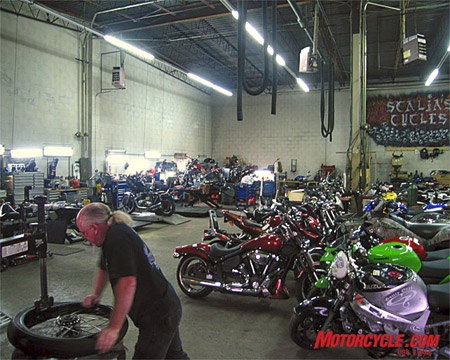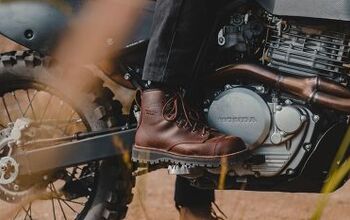Chain and Sprockets Swap
We’re guilty. Yeah, probably you too. Guilty of leaving our bikes’ bottoms to themselves for way too long. Rather ride than wrench ’em, eh? And true enough, gunky chains, mungy sprockets and such are not pleasant to ponder, let alone deal with. Yet, we ignore the nether regions to our peril.
That smarmy aggregation isn’t just gross in its own right. Leave it alone long enough and those knackered, highly stressed parts could see you off your sparkly mount in an eye-blink.
Some riders, granted, are astute enough to at least clean a tired chain and watch for wicking teeth on countershaft and drive sprockets. A fair number know to change out these parts as a set. Okay, it’s a messy chore and not cheap, time-or-buckswise. But it’s certainly worth it. Like to know how much? Me too.
To see what a simple switch-o-change-o would do for my ZX-11, we motored out to the guys at Fairfax Cycles & ATVs in Washington, DC’s bucolic Northern Virginia suburbs. They boast a state-of-the-art, 10-bay, 5200 square-foot facility with all the bells and whistles. Though mostly focused on metric bikes old and new, the majorly educated techs will fettle everything. Besides GSX-R-1000s, ‘Busas and ZX-everythings you’ll see ’60s Honda Dreams, ’80s Interceptors, new Aprilias, stunters and big snorkel-stacked quads.
They also sponsor their own quad and roadrace motorcycle teams. These guys are serious. For Milwaukee Twins lovers, a full-service Harley dealer, Scalia’s, adjoins the shop (Hey, maybe we can all get along!). Most notable for our purposes, however, was the Dynojet 250 dynamometer.
My Zixxer’s chain and sprockets weren’t done but were getting there fast. Not much adjustment latitude in the chain and some sprocket teeth were moving perilously far apart. I needed replacements. Editor Duke agreed to a brainwave: I’d dyno-compare new chain and sprockets with old. And no, he wouldn’t permit the one-tooth-less countershaft sprocket I’d wanted to freshen up Big Black’s low/midrange performance. Instead, we fitted the same gearing as stock: a 17-tooth front sprocket and a 45-tooth rear.
The shop maestros would do several pulls each with the oldsters, followed by the new tackle. Deep bows to manager Kevin Wright for arranging this and other above-and-beyond the call services. Previous rear-wheel best, back in the mid-‘90s, was about 131 hp. That’d be the benchmark.
Well, time, as is its annoying habit, had taken its toll: 10 horses had galloped off somewhere. With the old chain and sprockets, the dyno showed an average peak of 120 hp at the rear wheel. Ouch. “It’s tired,” intoned Wright. “It’s nice you had the carb slides synch’d lately, but what about a compression leakdown test?” Well, uh… “When were the plugs out last?” I, uh… “What’s the state of the combustion chambers?” But, I mean… “Look at that smoke on the overrun! Ever inspected or replaced valves and guides? The carbs?” My expression: pained and sheepish. His: “must do better.” And for sure, at almost 55,000 miles the beast could use a tune-up at the least.
Still, 120 hp’s 120 hp. Mightn’t the new drivechain components enliven the old girl?
Q&A with Brad Cameron, chain and sprockets guru
Now, pay attention. Regularly switching out flogged chains and sprockets is basic to your mount’s health. And, just possibly, yours. So says Brad Cameron, Renthal’s chain and sprockets guru. We got him to discourse on kinky links, sprocket science and other lore.
Motorcycle.com: The economy’s tight, Brad. Why not use bargain-basement chains? Or any plain roller chain for that matter?
Brad Cameron: For street use, we’d only recommend using some type of sealed ring chain, which could be any of the various styles; we offer a “Z” ring chain for better sealing and lubrication and less friction. Sealed ring chains offer better life and wear resistance and have much longer maintenance intervals than a standard roller chain. This is the reason most modern street bikes come with a sealed ring chain from the factory.
MO: While you’re at it, why not explain for denser MOrons the need for chain maintenance...
BC: Keeping your chain clean and lubed will do wonders for extending the life of your entire drive train, including the chain wheels. This is the number-one neglected area of chain maintenance. It’s always a good idea to follow the maintenance recommendations in the owners’ manual for your particular make. But if you’re a weekend warrior, it’s safe to say that lubing the chain after each ride is a good idea.
MO: Some of us lube after rides, some before. What’s the difference?
BC: The reason we say lubing the chain after the ride as opposed to before is that a warm chain will more easily accept lubrication into the critical pin and bushing area. But, if it’s not convenient to do after the ride, then a little before will be better than none at all.
MO: Can you say more about keeping the entire drive train healthy and new? Some riders scrimp here for reasons of cost, time, laziness, or because "the chain still looks pretty good..."
BC: Another cardinal rule to drive train maintenance is if one particular item is worn - either the countershaft sprocket, rear sprocket, or chain - then you must replace all three items together. If you replace just one of these worn-out items, you’re pissing money down the drain because a worn chain on new sprockets will wear ‘em out prematurely and vice versa. Your service manual or owners manual should show you how to tell if a sprocket/chain is worn and needs replacing.
MO: I hear some folks whining, “But Brad, I’ve lost my manual and live in the boonies!”
BC: One easy way to tell if your sprockets are in need of replacement is to look for hooking of the teeth. With chains, there are two things to look for to tell if it’s worn out. First look for tight or kinked links that don’t move freely. Second, grab one link at the back of the rear sprocket, if you can pull this link more than halfway up the teeth on the rear sprocket - time for replacement!
MO: A word or three about lightweight aluminum chain wheels and 520 conversions if you, please.
BC: We get asked questions all the time about converting a drive train to 520, and here’s the skinny. The reason you would want to convert your bike to 520 is to reduce the weight of your drive train and reduce revolving unsprung weight. Most sport bikes today come with larger chains in the 525, 530 range and also utilize steel rear sprockets for longevity. The benefits of performing this conversion are better performance and slightly quicker acceleration.
MO: Right, but all’s not rosy, I fear.
BC: The downside to doing a 520 conversion is that the entire drive train will wear much quicker and will require closer maintenance intervals. We generally recommend 520 conversions to racers only and/or bikes that see very little road use. All of Renthal’s road rear chain wheels are 7075 T-6 aluminum that have been hard anodized for increased life.
MO: If your advice saves even one MOron from a snapped chain and an unplanned slide off Pacific Coast Highway, our time’ll have been well spent. Thanks!
After a time-wasting glitch on parts delivery, a new D.I.D. 530 O-ring chain ($148.68) and JT steel sprockets ($24.95 front; $39.99 rear) were finally snugged into place. It’d been some weeks but few miles since Session No. 1.
I’d hoped the exercise to yield maybe a horse-and-a half gain. Actually, the dyno showed 2 hp less than before, 118 hp. The operators attributed it to different barometric pressure and ambient air temps from the last time, even though Dynojet’s weather station is supposed to correct for this. It wasn’t until later that a mechanic noted a leaking head gasket and found oil on the plugs, which sure sapped a few horsepower from the top end. Also, the dyno tuner insisted a jet kit alone would corral those AWOL 10 ponies and flatten the printout’s jaggedy bottom line. An aluminum rear sprocket might be good for a horse or two, said Wright, but then, they wear out a lot quicker.
So, the results proved anti-climactic. Were we disappointed? No. Well, okay, yes, a little. Still, the bike was riding on shiny new bits – ones which would be faithfully eyeballed, kept clean and replaced with monk-like devotion. And besides being quieter, it actually felt tighter, hence stronger in the actual riding. Sort of like when you’ve spent Sunday detailing your bike after a long time; it just seems faster, right?
For its part, Fairfax Cycles was well pleased. Here was one less bike whose drivetrain had been ignored to the point of failure and collapse. Freeing them for the more important duties: attending that trade show in LA and practicing for their next race!
_______________________________________
David Walsh is a writer and photographer based in the Washington, DC area.
More by David Walsh































Comments
Join the conversation